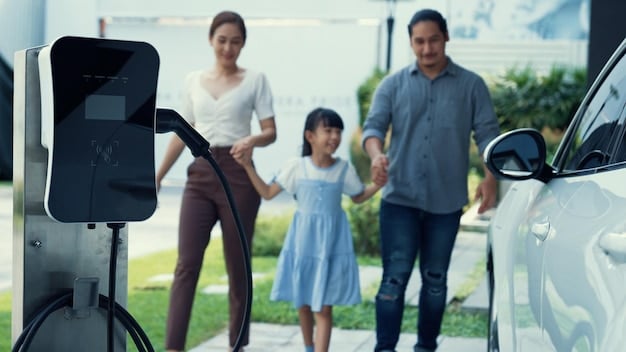Used Electric Vehicle Market Growth in the US: Key Factors

The growth of the used electric vehicle (EV) market in the US is primarily driven by increasing affordability, greater availability, growing environmental awareness, and supportive government policies and incentives encouraging EV adoption.
Interested in the burgeoning used electric vehicle market in the US? Let’s explore what are the key factors driving the growth of the used electric vehicle market in the US, and uncover the forces behind this electrifying trend.
Understanding the Rising Demand for Used Electric Vehicles
The used electric vehicle (EV) market is experiencing significant growth in the United States. This surge in demand contrasts with traditional internal combustion engine (ICE) vehicles, prompting a closer look at the elements fueling this trend. Several interconnected factors are responsible for this upward trajectory.
One of the primary drivers is the enhanced affordability of used EVs compared to their brand-new counterparts. As EVs age, their initial high price depreciates, making them accessible to a broader range of consumers. This price reduction addresses a crucial barrier to entry for many prospective EV buyers.
Price Depreciation and Affordability
The affordability of used EVs is a pivotal factor in their increasing popularity. New EVs often come with a hefty price tag, placing them out of reach for average consumers. However, as these vehicles enter the used market, significant depreciation occurs, making them more affordable. Consider these points:
- Initial Cost Barrier: New EVs tend to have higher upfront costs due to advanced technology and battery components.
- Depreciation Impact: Over time, EVs depreciate at a considerable rate, particularly in early years, softening the financial commitment.
- Broader Accessibility: Lower prices enable a wider demographic to consider EV ownership, boosting demand in the used market.
This price dynamic offers a viable pathway for ecologically conscious consumers to embrace electric mobility without breaking the bank. This financial accessibility is a major catalyst for the increased adoption of used EVs in the US.

The Expanding Availability of Used EVs
Another significant factor driving the growth of the used EV market is the increasing availability of these vehicles. As early adopters trade in or sell their EVs, a larger pool of used models enters the market, offering more choices for prospective buyers. This increased supply helps meet the growing demand and further stimulates market activity.
The initial wave of EV sales that began a decade ago is now contributing to a steady flow of used EVs. This expanded supply provides a greater range of options for consumers, encompassing different models, battery conditions, and price points. This trend contributes significantly to the accessibility and growth of the used EV market.
Growth in Supply and Variety
The increasing availability of used EVs stems from several factors related to production and consumer behavior. Here’s how the market supply is growing:
- Lease Returns: Many early EVs were leased, and as these leases expire, vehicles are returning to the market.
- Trade-Ins: As consumers upgrade to newer EV models, their older vehicles become available for resale.
- Model Diversity: A growing diversity in EV models initially sold has broadened the range available in the used market.
This expanded supply ensures that consumers have a variety of options, enhancing the overall appeal of the used EV market. This availability is a key component in sustaining the market’s growth momentum.
Government Incentives and Policies Supporting EV Adoption
Government incentives and policies play a crucial role in promoting the adoption of both new and used EVs. Tax credits, rebates, and other financial incentives can significantly reduce the overall cost of EV ownership, making them more attractive to consumers. These policies often extend to the used EV market, furthering its growth.
Federal and state governments offer a range of incentives to encourage EV adoption. These can include:
- Tax credits for purchasing used EVs.
- Rebates that reduce the upfront cost.
- Subsidies for installing home charging stations.
The Inflation Reduction Act of 2022, for instance, offers up to $4,000 in tax credits for the purchase of used EVs that meet certain criteria. Such policies significantly lower the barrier to entry for many consumers.

Environmental Awareness and Sustainability Goals
Increasing environmental awareness is a major driver behind the growing demand for EVs, irrespective of whether they are new or used. Consumers are becoming more conscious of their carbon footprint and are actively seeking ways to reduce it. Electric vehicles offer a compelling solution, as they produce zero tailpipe emissions and can significantly lower overall emissions when powered by renewable energy sources.
Numerous sources now provide greater data regarding the environmental impacts of EV adoption. For example:
- EVs produce zero tailpipe emissions, improving air quality.
- Combining EVs with renewable energy sources drastically reduces carbon footprints.
- The extended lifespan of EV batteries contributes to overall sustainability.
This environmental emphasis resonates particularly with younger generations and eco-conscious households, fueling a shift toward electric mobility. As awareness spreads, so too does the demand for both new and used EVs.
Advancements in Battery Technology and Range
The continuous advancements in battery technology are also contributing to the growth of the used EV market. Newer EVs boast longer ranges and more efficient batteries compared to older models. This technological progression positively impacts the used market by increasing the appeal of older EVs with reasonable battery life and performance.
Improvements in battery technology include:
Greater Energy Storage Capacity
Newer batteries offer significantly higher energy storage capacity, enabling EVs to travel longer distances on a single charge. This extended range makes EVs more practical for daily use and long trips.
Enhanced Battery Management Systems
Advanced battery management systems (BMS) optimize battery performance and lifespan. These systems ensure batteries operate efficiently, safely, and reliably, enhancing consumer confidence in EV technology.
Improved Charging Capabilities
Faster charging technologies reduce the time required to replenish EV batteries. Rapid charging infrastructure is expanding, making it more convenient for EV owners to recharge their vehicles on the go, alleviating range anxiety.
Consequently, even older EVs retain value, making them attractive options in the used market. The continuous evolution of battery technology enhances the desirability of used electric vehicles, bolstering market growth.
Infrastructure Development and Charging Accessibility
The expansion of charging infrastructure is critical for supporting the adoption of EVs. A widespread and reliable charging network reduces range anxiety among potential buyers and makes EV ownership more convenient. Both public and private investments in charging infrastructure are accelerating, leading to greater access and fueling the used EV market.
Expanded charging accessibility allows owners to easily charge EVs at home, work, or on the road. This convenience transforms EV ownership into a practical lifestyle choice. Points to consider include:
- Public Charging Stations: Expanding networks of fast-charging stations make long trips more feasible.
- Home Charging Solutions: More options are available for installing Level 2 chargers at home, enabling overnight charging.
- Workplace Charging: Many employers install charging stations to benefit employees.
This infrastructure growth alleviates one of the primary concerns among potential EV adopters: the availability of convenient charging options. As charging becomes more ubiquitous, the desire for used EVs will continue to rise.
| Key Point | Brief Description |
|---|---|
| 💰 Affordability | Used EVs offer a more budget-friendly option than new models. |
| 🚗 Availability | The supply of used EVs is increasing with lease returns and trade-ins. |
| 🌱 Environmental Awareness | Consumers are increasingly considering the environmental impact of their vehicles. |
| ⚡ Infrastructure | Expanded charging networks reduce range anxiety and improve convenience. |
Frequently Asked Questions (FAQs)
▼
Used EVs are gaining popularity due to their lower prices compared to new models, making them accessible to a wider range of consumers. Plus, they offer environmental benefits.
▼
Government incentives like tax credits and rebates are available for used EVs, helping to reduce the overall cost. The Inflation Reduction Act offers up to $4,000 in tax credits.
▼
Advancements in battery technology have improved the range and lifespan of EVs, making older models still valuable and attractive in the used market.
▼
The charging infrastructure is expanding, making it easier for used EV owners to charge at home, work, and public charging stations. This improves convenience and reduces range anxiety.
▼
With growing environmental awareness, consumers are looking for ways to reduce their carbon footprint, and used EVs provide an affordable and sustainable transportation option.
Conclusion
In summary, the used electric vehicle market in the US is thriving due to a combination of factors: increasing affordability, greater availability, supportive government policies, environmental awareness, improved battery technology, and expanding charging infrastructure. These elements collectively contribute to the growing appeal and accessibility of used EVs, driving their adoption across the country.





